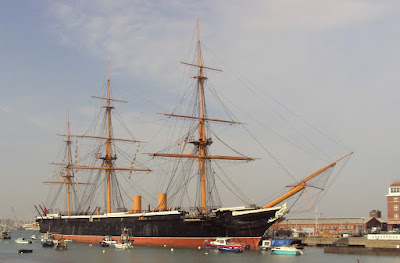Portsmouth is the UK's only island city and the inlet between it and Gosport opposite creates a natural harbour. It has been a strategic naval port for centuries.
 |
| Portsmouth |
The city of Portsmouth was contained with it's walls, with further defences to defend the Naval Dockyards.
 |
| Portsmouth City and Dockyards 1773 |
 |
| Gosport and Portsmouth 1895 |
The Gunwharf area where cannons, ammunition and other armaments were stored, repaired and serviced lay north of Portsmouth. As armaments on ships became permanent the area fell in disuse, being revived in 1923 as HMS Vernon, the Navy's torpedo school.
Portsmouth and the dockyards were heavily bombed during World War Two and many old buildings destroyed. The naval site was rebuilt, continuing in use till 1995. It was re-generated as a shopping and residential area at the beginning of the 21st century, the Spinnaker Tower dominating the Portsmouth landscape.
 |
| Portsmouth Gunwharf HMS Vernon occupied Old Customs House |
The Portsmouth Royal Dockyard was established in 1496, and was the first of the Navy's dockyards where ships were built, fitted and repaired, as well as being their base for operations. Today the Dockyard houses the Royal Navy Museum, the Mary Rose, HMS Victory, HMS Warrior and other historic naval attractions.
 |
| HMS Victory |
 |
| HMS Warrior |
It was from Portsmouth that Nelson sailed in HMS Victory to lead the British fleet against the French at Trafalgar in 1805.
 |
| Portsmouth Nelson's Statue |
Her Majesty's Naval Base (HMNB) Portsmouth is the home of the Royal Navy and is the headquarters for two thirds of the surface fleet. It is the base for the two aircraft carriers, HMS Queen Elizebeth and HMS Prince of Wales.
The Portsmouth Naval Memorial records the names of Royal Naval Personnel who were lost during both World Wars.
---------0--------
PORTSMOUTH





.JPG)
.JPG)



































